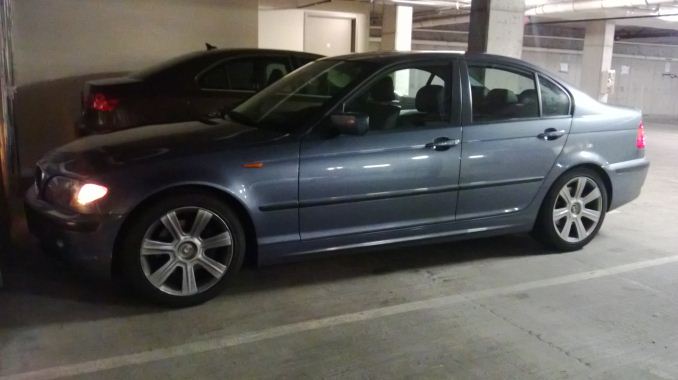Nokia Lumia 521: Quality Smartphone on an Extreme Budget
by Vivek Gowri on August 8, 2013 1:08 AM EST- Posted in
- Smartphones
- Nokia
- Mobile
- windows phone 8
- Lumia 520
- Lumia 521
The camera, on paper, looks pretty competitive. The 5MP resolution won’t blow anyone away, but as we’ve noted recently and before, resolution isn’t the biggest deal in the world. The plastic optical system with a f/2.4 lens indicated some promise, though. This being Nokia, obviously the natural expectation is for the imaging system to hold its own.
And for the most part, it actually does. The image files by default are 16:9 aspect ratio, with a resolution of 2592x1456. This isn’t exactly 16:9 actually—that would be 2592x1458—but it’s near enough to make no difference. The rest of the camera interface is pretty much the same as what we’re used to in most other Windows Phones, with the exposed manual control options being limited to ISO, exposure, white balance, aspect ratio, and four scene modes. And I know I covered this before, but I really liked the camera button; it’s a shame that more phones don’t have solid two-stage camera buttons with good, positive feedback.
In well-lit scenarios, image quality is pretty solid, with good colors and reasonable sharpness. It won’t blow anyone away, but this is easily on par or ahead of where we were in terms of smartphone imaging before the Galaxy S2 and iPhone 4S came out in the latter half of 2011. What actually surprised me was that the images looked pretty solid when viewed at 1:1 on my 30” display (the 2560x1600 resolution is very close to that of the image output, which made it easier). Definitely much better than I was expecting, and actually better than many of the smartphone camera stills that I’ve accumulated over the years, particularly ones more than a year old.
The low light story is mixed. On the one hand, the lens is bright enough to give you pretty reasonable images in dimly lit situations, with good detail and not as much of the grainy mess I was expecting. It's worth noting that in dimly lit scenarios, the shutter speed is a bit slow so it's pretty easy to end up with blurry images if you aren't careful. These are usable, social media-worthy photos though, and that’s really all that can be asked from a phone like this. On the other hand, there’s a distinct lack of fancy features. Like a flash. Yeah. So while the 521 is a decent low light camera, if low light is really closer to no light, you’re out of luck.
As noted before, there’s no front facing camera either. It’s not a huge deal for me, because I rarely make use of the feature—Skype video calls from my phone just aren’t part of my normal usage model—but it’s something that could count as a pretty big omission for some people, particularly internationally. I think an LED flash and a front facing camera probably could have been included for not that much more, perhaps an increase of $10 on the price would have covered it, but I can understand why Nokia would be so hesitant to increase BoM costs on a device like this.



















116 Comments
View All Comments
Death666Angel - Thursday, August 8, 2013 - link
Huh, wasn't even aware of this phone. That's pretty good value for 140€. If my wife didn't have a Chinese phone since Christmas, I'd get her one of these.Gunbuster - Thursday, August 8, 2013 - link
I love this little phone. Having jumped on the deal at HSN for $80 I could destroy this phone 6 times over and still be ahead of buying a "high end" handset.You get 90% the capabilities of better phones at a price that is over 80% lower.
kmmatney - Thursday, August 8, 2013 - link
Can you use the AT&T GoPhone version with a normal regular AT&T plan? I'm tempted to sell my 4S 32GB before before the new iPhones come out, and use this for a while.thesavvymage - Thursday, August 8, 2013 - link
yeah you just pop in the SIM and it will work since it is compatible with AT&T's frequenciesImpulses - Friday, August 9, 2013 - link
At one point in time AT&T actually flagged GoPhone IMEIs and wouldn't let you use them with pre-paid plans tho, this was a few years ago, no clue if it's still in practice.jabber - Thursday, August 8, 2013 - link
Must admit at 1:1 the pics from the 520/521 look better than the pics taken with the Nexus 4 at 1:1VivekGowri - Thursday, August 8, 2013 - link
Yeah, I wouldn't disagree with that statement.Azurael - Friday, August 9, 2013 - link
The Nexus 4's camera is notoriously bad though. I don't know what LG were thinking! It's the only thing that's even giving me thoughts about upgrading to one of this year's latest and greatest handsets. Certainly not the 400+ PPI I can't discern displays or swanky new SoCs (which are only marginally faster than the S4 Pro in the N4 but driving 1920x1080)Then I remind myself that ALL mobile cameras, regardless of how 'good' they look AS mobile cameras - Nokia Pureview being a possible excepetion - are dreadful compared to the cheapest 1/2.3" sensor-equipped compact cameras, let alone anything better with a larger sensor. In fact, when I did have a phone with a better camera (One X), I didn't use it any more than I do with the terrible camera in the N4 now.
ljlego - Thursday, August 8, 2013 - link
"Far too often, you see important functions and options pushed into random corners of the interface, buried deep in some menu."That's a pretty bold claim that I have never experienced, personally. Could you maybe provide an example of when you've found this?
Collin5 - Thursday, August 8, 2013 - link
@VivekA well done review! It is balanced and it includes a lot of useful information not found anywhere else. Thank you!
However, I also feel there are a few statements, related to multitasking and overall performance, which paint a picture with too broad a brush. Nothing critical or wrong, but something you may want to look into for future reviews of WP devices:
1)
"Multitasking in Windows Phone has never really sat well with me, because it’s not really multitasking in the traditional sense—the need to completely close and rehydrate tasks makes resuming applications exceedingly slow."
On my Lumia 520 app switching occurs instantaneously most of the time. Only when I open more apps than the device can fit into RAM, is the least frequently used app completely closed out (tombstoned). Only when switching back to a tombstoned app does the rehydration process kick in (which I agree is too lengthy). However, even the Lumia 520 can simultaneously cache two or three apps in memory, which is enough to get through most multitasking scenarios without tombstoning occurring.
Saying that "the need to completely close and rehydrate" is too much of a blanket statement. That need only exists in very specific circumstances, which some may encounter only very rarely (depending on how people use their device).
2)
"...but in day to day use, it mostly makes itself felt in slower application loading and multitasking/task switching, which is also related to having just 512MB RAM instead of the 1GB of the 920."
This could be understood to imply that having less RAM negatively impacts the time it takes to load apps AND the time it takes to task-switch between them, which is false. Having less RAM has no affect on app load times. Having less RAM also has no direct impact on the time it takes to switch between apps. Having less RAM only has an indirect affect on task-switching in the way I already mentioned... RAM capacity determines how soon apps are tombstoned. That is all. Both app load times and rehydration (basically the same thing) are directly impacted by the slower CPU however.
Certainly we can argue that the probability of a task requiring rehydration is greater on a 512 MB device, but that is what I would expect an article on Anandtech to explicitly state, instead of attributing app load performance directly to RAM capacity ;-)